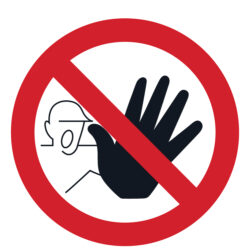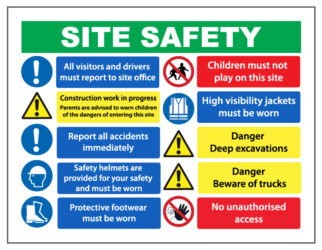Questions & Answers
Correct Answer
Continue working
Report to the supervisor immediately
Patch up the equipment and continue working
Ensure new equipment is ordered but continue working
50v supply only.
110v supply only.
220v supply only.
both 110v and 220v supply.
The operative must wear a hi vis jacket
The operative must be under the age of 18.
The operative must have written permission from their employer
The operative must be over 18 years of age, trained and tested for colour blindness.
Gloves, safety gaiters and a safety helmet
Earmuffs, safety footwear and safety helmet
Eye protection, ear protection and a safety helmet
A safety helmet, protective leggings and ear protection
Noise
Over stretching
Disintegration of the wheel
Penetration of a work surface
Any competent person
a mobile elevated work platform (MEWP) operator
Anyone who knows how to use the equipment
A trained and competent person appointed by the employer
20 db(A)
80 dB(A).
10 db(A)
40 db(A)
Carry out the works as quickly as possible
Only use one power tool on site at any one time
Only carry out these activities when there is no wind
Put in measures to stop dust from getting into the air
To protect eyes from dust
To give more weight to the tool
To stop the risk of over speeding
To deflect sparks and debris away from the user
A machine operator
the site foreman.
a competent and authorised person.
anyone by following the manufacturer's instructions.
at all times.
if you are indoors.
if you are on an excavation site.
if you are outside and it is windy.
Face mask and ear defenders
Hi-vis jacket and safety helmet
Steel-toe capped boots and hi-vis jacket
Goggles, shield or visor and ear defenders
All equipment defects must be reported.
All hired equipment must be checked before it's used.
Makeshift equipment can be used if work needs completing.
Equipment must be inspected regularly by a competent person.
if the manufacturer's label is still in good condition.
if there is a newer model that could be used instead.
that the power lead, plug and casing are in good condition.
that the switches, triggers, and guards are adjusted and work correctly.
Reduce the amount of twisting
Reduce the time in consideration of the lift
Reduce the amount of stooping and reaching
Reduce the number of items that you lift
All dumper trucks have reversed parked at the end of the shift with the key left in the ignition.
All drivers are competent and hold a current CSCS card relating to operating a site dumper truck.
That a GPS is fitted to the dumper truck to monitor vehicle movements and productivity of each driver.
The skip of the dumper should never be overfilled or overloaded to the point where material could fall out and injure someone.
A safety incident that did result in injury, illness, or death.
A safety incident that did not result in death but had the potential to do so.
A safety incident that did not result in injury, illness, or death but had the potential to do so.
A safety incident that did result in minor injury or illness but had the potential to be much worse.
That all operatives are first aid trained.
Safe and suitable access ways are provided.
Traffic and pedestrian routes are organised and controlled.
That all access roads are tarmaced with traffic light systems in place.

You are about to enter an exclusion zone. Any inducted operative can enter.
You are about to enter an exclusion zone. Only enter if you are permitted to.
Do not enter. Health & Safety Authority on site.
You must stop what you are doing and ensure you are wearing the necessary site personal protective equipment before entering.
Ensure operatives are competent and authorised.
Only use construction equipment that is less than 5 years old.
Follow the manufacturer's recommendation for use and maintenance.
Any operative using construction equipment must have someone supervising them.
unload or tip material into an excavation.
carry persons on plant not designed for the purpose.
affix signs to vehicles not designed to accomodate passengers.
load loose material onto a vehicle that is fitted with a purpose-built overhead guard.
After lunch
When following the site rules
When they first start on a new site
After their first 3 months on a new site
Secure ladders
Toe board and guard rails
Netting surrounding the base of the platform
Fencing at approximately 3m all the way round the base of the platform

only starts after you pass this point.
is for the operatives who work on site.
takes place within a 5m radius of where you can see this sign.
is of upmost importance on this site and is enforced throughout the area.
If an injury results in a trip to the hospital
If a bone is broken because of an incident
If you need to report details of specified work-related injuries and incidents
If you will miss—or already have missed—7 consecutive work days (not including the day of the incident)
Individual capability
The nature of the load
Environmental conditions
The principle designer's plan
site audit.
site survey.
risk assessment.
method statement.
Throw away the drill and use another one.
Stop work immediately and inform your supervisor.
Using insulating tape, tape up the cable and carry on using the drill.
The drill is only for use on light work, so you can carry on using the drill.
be replaced every week
be replaced after each project.
have handles that are secure and free from splits.
be sharpened properly if they are a cutting or drilling tool.
servicing information.
information on its country of origin.
instructions and safety information.
brand name and manufaturing date.
Find a team member with functioning ear defenders and share them.
Ignore the issue, proceed to your work site and undertake your work duties.
Stop what you are doing and only carry out the activity when you are issued a new pair.
Take off the faulty ear defenders and use noise cancelling earphones whilst undertaking the activity.
signage provided for the public.
controlled traffic and pedestrian routes, with safe ways provided.
a minimum of one banksman provided outside the construction site.
an approval notice from the local authorities on display at the site entrance.
It is essential that the right abrasive wheel for the job is chosen.
Some form of eye protection must be used, either goggles, a face shield or a visor.
Any shields supplied by the manufacturer need to be altered by the operator to permit exposure of the correct amount of abrasive wheel.
Accumulation of hot sparks within a machine's guard pose significant risk, so guards must be left off when working in a confined space.
The time it might take to cut the material
The direction of the hot sparks when using the machine
The direction of the abrasive wheel particles when using the machine
The possible disintegration of the cutting wheel while using the machine

In the site canteen
At the site entrance
Within the welfare facilities
Attached to any and all construction vehicles
less than 5 persons employed at any one time.
more than 20 persons employed at any one time.
between 5 to 10 persons employed at any one time.
between 11 to 19 persons employed at any one time.
be trained first aiders.
understand the need to have a proper emergency and rescue plan in place.
have signed a Release of Liability, Assumption of Risk and Indemnification agreement.
have reviewed footage of previous trapping incidents occurring between the platform of a MEWP and an obstruction.
You can choose any of these 5 items of PPE to wear on this site.
As long as you are wearing at least 5 items of PPE, you can work on this site.
You only require these 5 items of PPE to work on this site, regardless of the task you are carrying out.
These 5 items of PPE must be worn at all times on this site, but other items of PPE may be required, depending on the task you are carrying out.
be refurbished by the manufacturer.
be approved for use and supplied by the Health and Safety Authority.
have a GA1 form (Report of Thorough Examination) that has been inspected and signed by the contractor.
have a GA1 form (Report of Thorough Examination) that has been completed by a competent person.
emergency exit routes and site traffic rules.
where the turning circles are for lorries and vans.
how to manage incoming deliveries and diverting them for storage.
where the site offices are for reporting an injury to the site manager.